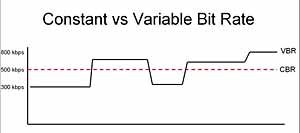
CBR versus VBR in video encoding
When referring to codecs, CBR (constant bitrate) encoding means that the rate at which a codec’s output data should be consumed is constant. As opposed to constant bitrate, VBR (variable bitrate) vary the amount of output data per time segment. VBR allows you to set a maximum and minimum bitrate. The advantages of VBR are that it produces a better quality-to-space ratio compared to a CBR file of the same data. The bits available are used more flexibly to encode the sound or video data more accurately, with fewer bits used in less demanding passages and more bits used in difficult-to-encode passages.
The disadvantages are that it takes more time to encode, as the process is more complex. VBR may pose problems when streaming over a web connection since it is the maximum bit rate that matters, not the average.
The generally accepted best practice is to use CBR when producing for streaming delivery, and VBR when producing for progressive download.
